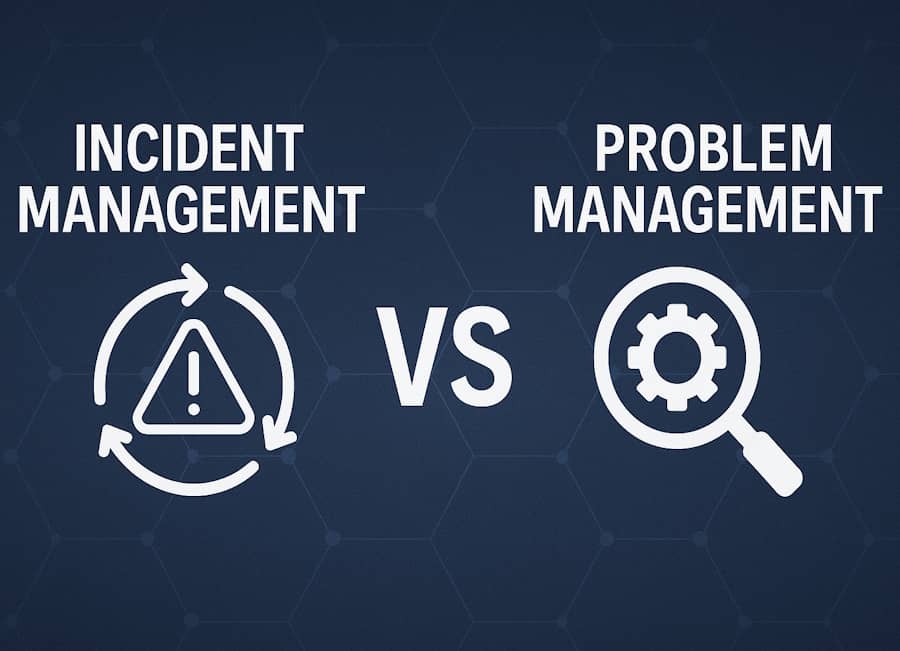In the world of IT service management (ITSM), two terms are often used interchangeably but represent very different concepts – Incident Management and Problem Management. Both play crucial roles in maintaining smooth IT operations, but their objectives, processes, and outcomes differ significantly. Understanding these distinctions can help organizations improve service quality, minimize downtime, and prevent recurring issues.
Let’s take a closer look at how these two processes interact, where they differ, and how companies can leverage both to build a more reliable and efficient IT environment.
Defining Incident Management
Incident Management is the process responsible for restoring normal service operation as quickly as possible after an unplanned interruption or reduction in service quality. The key focus here is speed and efficiency. When an incident occurs – for example, a user cannot log in to an application, or the network is down – the IT team must act swiftly to get things back on track.
The purpose of Incident Management is not necessarily to find the root cause, but to mitigate the immediate impact on users and business operations. In other words, it’s about putting out the fire so that normal activity can resume, even if the underlying issue hasn’t yet been diagnosed or fixed.
Most organizations manage incidents through structured workflows defined by ITIL (Information Technology Infrastructure Library) frameworks. These workflows typically involve detection, logging, categorization, prioritization, investigation, resolution, and closure.
Example:
Imagine your company’s CRM system suddenly crashes during peak working hours. The Incident Management team’s job is to restore access to the system as soon as possible – perhaps by restarting the affected server or switching users to a backup system. The goal is service restoration, not necessarily figuring out why it crashed.
Understanding Problem Management
While Incident Management deals with immediate disruptions, Problem Management focuses on identifying and eliminating the root causes of those disruptions. This process aims to prevent incidents from recurring and to reduce the overall impact of problems on the organization.
In simple terms, if Incident Management is about firefighting, Problem Management is about fire prevention. The goal is to analyze patterns, identify underlying issues, and implement long-term fixes that eliminate recurring pain points.
Problem Management typically includes two main activities:
- Reactive Problem Management – identifying problems from one or more incidents and taking steps to find permanent solutions.
- Proactive Problem Management – analyzing trends and data to detect potential issues before they cause incidents.
Example:
Returning to the CRM system crash example – after the incident is resolved, the Problem Management team would investigate why the crash occurred. Perhaps a software bug caused a memory leak, or a database update conflicted with a plugin. The team would then implement a permanent fix, such as applying a patch or adjusting system configurations.
Key Differences Between Incident and Problem Management
Although both processes are closely linked, they differ in purpose, timing, and outcome. The following table provides a clear comparison between the two:
|
Aspect |
Incident Management |
Problem Management |
|
Objective |
Restore normal service as quickly as possible |
Identify and eliminate root causes of incidents |
|
Focus |
Short-term resolution |
Long-term prevention |
|
Approach |
Reactive – responding to incidents as they occur |
Proactive and analytical – identifying underlying issues |
|
Outcome |
Service restored, users satisfied temporarily |
Permanent fix, prevention of recurrence |
|
Typical Question |
“How can we fix this quickly?” |
“Why did this happen, and how do we stop it from happening again?” |
|
Tools Used |
Incident tracking systems, service desk tools |
Root cause analysis, trend reports, knowledge bases |
|
Responsibility |
Service desk and support teams |
Problem analysts and technical specialists |
|
Frequency |
Happens frequently, every time a service disruption occurs |
Happens less often, but requires deeper investigation |
These distinctions make it clear that while both processes overlap, they address different layers of IT service quality. Successful organizations recognize that neither can function effectively in isolation – they complement each other as part of a holistic ITSM strategy.
How Incident and Problem Management Work Together
The synergy between these two processes is essential. Incident Management ensures that service interruptions are quickly addressed, minimizing downtime and user frustration. Problem Management, on the other hand, ensures those interruptions don’t happen again in the future.
Here’s how they typically interact:
- Incident Detection: A user reports a service outage or slowdown.
- Incident Resolution: The IT support team restores service using a temporary fix.
- Problem Identification: The recurring nature or impact of the incident prompts an investigation.
- Root Cause Analysis: The Problem Management team performs detailed analysis to identify what’s causing the issue.
- Permanent Resolution: A long-term fix is implemented, preventing recurrence.
- Knowledge Sharing: Both teams document the findings and share them in a knowledge base to improve future responses.
This collaboration ensures that short-term responsiveness (Incident Management) and long-term stability (Problem Management) work in harmony – creating a seamless experience for users and a resilient IT infrastructure for the business.
Benefits of Implementing Both Processes
Organizations that successfully integrate both Incident and Problem Management can achieve measurable improvements in IT performance and customer satisfaction. Let’s explore the major benefits:
- Reduced Downtime – Quick resolution of incidents minimizes the impact on users and business operations.
- Improved Service Quality – Root cause elimination ensures fewer recurring issues.
- Cost Efficiency – Preventing problems reduces the time and resources spent on repetitive fixes.
- Higher Customer Satisfaction – Consistent service reliability leads to happier users.
- Better Knowledge Management – Both processes contribute valuable data for training, analytics, and decision-making.
- Enhanced IT Team Productivity – Clear separation of duties allows teams to focus on what they do best – incident responders on speed, and problem solvers on precision.
By focusing on both immediate recovery and long-term improvement, businesses can transform their IT departments from reactive support units into proactive value creators.
The Role of Technology in Streamlining ITSM
Managing incidents and problems effectively requires more than just good intentions – it requires robust software tools that can automate workflows, facilitate collaboration, and provide deep visibility into IT performance. This is where modern ITSM solutions like Alloy Software come into play.
With advanced automation, AI-driven insights, and integrated dashboards, Alloy Software enables IT teams to track, resolve, and prevent issues efficiently. The platform provides features for incident logging, problem tracking, root cause analysis, and knowledge base management – all within a unified environment. This allows IT departments to reduce manual work, speed up response times, and improve service consistency across the organization.
When choosing an ITSM platform, look for tools that provide:
- Centralized service desk capabilities
- Integrated problem and incident tracking
- Customizable workflows
- Reporting and analytics
- Automation and AI-driven recommendations
The right technology doesn’t just simplify processes – it empowers teams to deliver exceptional service while continuously improving IT stability.
Practical Tips for Balancing Incident and Problem Management
Building an effective balance between these two processes takes time, but there are best practices that can guide you:
- Establish Clear Roles and Responsibilities – Ensure the service desk focuses on resolving incidents, while problem analysts handle root cause investigations.
- Encourage Communication Between Teams – Incident and Problem Management teams should work hand in hand, sharing knowledge and insights.
- Use a Central Knowledge Base – Document known errors, solutions, and workarounds to speed up both incident and problem resolution.
- Adopt Automation Wherever Possible – Use automated alerts, categorization, and escalation to reduce manual effort and human error.
- Monitor KPIs Regularly – Track metrics like Mean Time to Resolve (MTTR), incident volume, and problem recurrence rates.
- Promote a Culture of Continuous Improvement – Encourage IT staff to proactively identify recurring issues and suggest permanent fixes.
These practices not only improve operational efficiency but also build a stronger, more agile IT ecosystem.
A Real-World Example: From Reactive to Proactive IT
Consider a global manufacturing company struggling with frequent email outages. Each time an outage occurred, the IT team rushed to bring the system back online – a textbook example of Incident Management. However, after several similar incidents, they initiated a Problem Management process.
By analyzing logs, they discovered that a memory overflow in the mail server caused the failures. A software patch was developed and implemented, completely eliminating the recurring issue. As a result, email uptime improved from 95% to 99.9% – saving hours of lost productivity and significantly boosting employee satisfaction.
This example illustrates how integrating both processes can transform IT operations from constantly reacting to issues into strategically preventing them.
Conclusion: Two Processes, One Goal
Incident Management and Problem Management are two sides of the same ITSM coin. One focuses on speed and service restoration, while the other ensures stability and prevention. Together, they create a balanced, efficient, and proactive IT environment.
Organizations that invest in both areas – supported by modern ITSM tools like Alloy Software – can expect fewer disruptions, better user experiences, and a more resilient technological foundation. In the end, success in IT service delivery isn’t just about solving today’s problems; it’s about preventing tomorrow’s.








